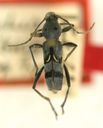Clytus
Clytus
Classification
- Phylum: Arthropoda
- Subphylum: Hexapoda
- Class: Insecta
- Order: Coleoptera
- Suborder: Polyphaga
- Superfamily: Chrysomeloidea
- Family: Cerambycidae
- Subfamily: Cerambycinae
- Tribe: Clytini
- Genus: Clytus
Pronunciation
How to pronounce Clytus: //ˈklaɪtəs//
These audio files are automatically generated. While they are not always 100% accurate, they are a good starting point.
Images






Summary
Clytus arietis is a wasp-mimicking longhorn beetle known for its distinctive yellow and black coloring. It is a Saproxylic species, relying on dead and decaying wood for its lifecycle. It plays a significant role in ecosystem health through its pollination and decomposition activities.
Physical Characteristics
Clytus arietis reaches 9–18 mm in length and features prominent yellow and black patterns along its head and abdomen. The beetle possesses thin legs and antennae that move in small, quick movements. It has a relatively short antenna compared to other longhorn beetles and shows very little variation in its markings. A rare variety lacking the yellow V-shaped elytral mark (var. medioniger) has been described.
Identification Tips
Look for the wasp-like coloring and size. It can easily be confused with other wasp-mimicking longhorn beetles, such as Rutpela maculata. Notable identifiers include its short antennae, prominent yellow and black patterns, and relatively thick body compared to more pointed bodies of other longhorn beetles.
Habitat
Clytus arietis thrives in farmlands, woodlands, towns, and gardens. It prefers hedgerow vegetation and well-wooded areas for breeding but can be seen visiting flowers far from suitable habitats.
Distribution
This species is widespread in England and Wales, rare in Scotland, and found throughout Europe, extending from Portugal to Southwestern Russia and from Southern Norway to Southern Italy.
Diet
Adult wasp beetles feed on pollen and occasionally small insects, particularly favored are Umbels (Apiaceae) and dog rose. Larvae feed on dry deciduous deadwood.
Life Cycle
The entire life cycle generally takes two years, but adult beetles can take several years to emerge in certain conditions. Adults appear from May to reproduce and then die by the end of summer, leaving offspring to emerge in either the Fall or the following Spring.
Reproduction
Reproduction occurs as adults emerge in Spring and lay eggs in deadwood, particularly under the bark. Courtship involves a 'courtship song' and 'lick-tapping' behavior.
Predators
Birds are the most common predators of Clytus arietis. While Batesian mimicry helps to avoid predation, environmental factors significantly affect predation risk.
Conservation Status
This species is common and of no concern, though it is scarcer in Scotland.
Ecosystem Role
As a Saproxylic beetle, Clytus arietis plays an essential role in decomposition, nutrient cycling, and pollination within its ecosystem.
Economic Impact
Clytus arietis is economically important for its pollination activities, supporting agricultural ecosystems.
Evolution
Clytus arietis exhibits Batesian mimicry, adapted to protect itself from predation through its coloration and behaviors that resemble those of wasps, an evolutionary trait beneficial for survival.
Similar Taxa
- Rutpela maculata
- Clytus ruricola
- Xylotrechus undulatus
- Plagionotus arcuatus
Misconceptions
The Wasp Beetle is harmless despite its wasp-like appearance and buzzing noise, which may lead to the mistaken belief that it is dangerous.
Tags
- Clytus arietis
- wasp beetle
- pollination
- Batesian mimicry